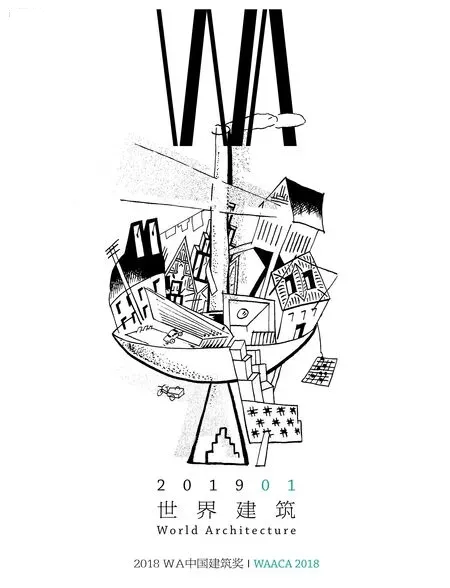在无穷知识时代寻觅设计的佳境
张利/ZHANG Li
我们不再清晰了解我们还有哪些不知道的,这已不是什么新闻。知识不再以可预测的方式出现,这也已不是什么新闻。目前,全世界的远见卓识者们都乐于谈论以设计思维取代传统的人文与科学二分法,并将其视为桥接已知与未知的一种全新方式。
在2018年其清华荣誉博士的授予仪式上,托马斯·普利兹克发表的演讲“无穷知识时代的设计思维”令在场的400多位听众心潮澎湃。当然,普利兹克使用的“设计思维”一词并不指我们建筑师所熟悉的建筑设计,更是代表了一种思维方式,一种面对繁复问题,试图在问题本身尚不可尽知的情况下发掘出明智解决方案的思维方式。这种思维方式现在被商业、金融、工程、科学、艺术等领域的引领人群广泛采用。有趣的是,建筑师好像通常并不这么做。
建筑师,或作为一个整体的建筑人,是喜欢在已知中工作的。考虑到建筑学是多么喜欢说教——毕竟几个世纪甚至上千年来的建筑学习都是通过追随已知者而完成的——这不足为怪。展示这种建筑学认知习惯的一个典型案例就是建筑奖项。评委裁断与获奖项目通常被默认为指南针,试图明确定义当前建筑发展的方向。
然而,在2018 WA中国建筑奖中,评委和参与评审的每一个人都达成了一种新的共识:我们可以在建筑奖项中不再以寻求答案为目的,而是寻求对问题的创造性定义。这样可以使建筑奖项更好地发挥在当代的作用。换句话说,我们可以把思维方式转化到更适合我们无穷知识时代的方式上。在整个评审过程中,拥有杰出判断和智慧的评委们一直坚持了极其开放的态度,既精彩,又令人耳目一新。或许2018年的评审地与任何一个大城市之间的痛苦遥远的距离在这方面反倒起到了一定的作用。设计实验奖、城市贡献奖、居住贡献奖和社会公平奖的评议争论中,目标从最佳解答范例向最创新问题定义的转变显而易见。
我们对这一转变感到兴奋。这并不是因为我们已经厌倦了(也许我们确实有些厌倦了)过度修饰美化的建成环境的照片;这并不是因为我们已经听够了(也许我们确实有点听够了)经过编排的穷困社区的同情故事;这并不是因为我们已经不相信(也许我们确实已经开始怀疑)一些为证明技术有效性而选择性列举的数字;而是因为,作为获取当前无穷知识时代我们所处世界的真知的途径,这一转变开启了寻觅设计佳境的新维度。
我们特别感谢所有的评委和所有的申报者。是他们,在无穷知识的时代让这种对设计佳境的探寻成为可能。
It is not news that we are no longer able to be aware what we do not know. Either is it news that knowledge no longer comes in the predictable way.Visionaries around the world are now looking at design thinking as an alternative way of bridging the known with the unknown, replacing the conventional dichotomy between humanities and science.
In his acceptance speech of honourable doctor degree in Tsinghua University in 2018, Mr. Thomas Pritzker thrilled an audience of over 400 with a talk on "Design thinking in the age of not-knowing". Of course, the term "design thinking" he used was not only referring to the design we architects know, but a way of thinking as trying to develop a sensible solution when the problem is still too complicated to be fully understood. That thinking pattern is now widely adopted by people from a variety of fields:business, finance, engineering, science and art.Interestingly, not typically by architects.
Architects, or architecture people as a whole,like to work in the knowing. Given how didactic architecture is, it is not surprising that for centuries, even millenniums, architecture are learnt by following those who know. One good way of demonstrating this knowing pattern is the making architecture awards. Jury verdicts and winning projects are usually compasses, pointing out the direction of the current architectural movement.
Yet with 2018 WAACA, jurors and everyone involved in the jury sessions have come to a consensus, that architecture awards can be better if what is being searched is not only sound answers, but creative questions. Or, if we would change our pattern of thinking to one that fits our time of not-knowing. In short, the openmindedness of all the distinguished jurors has been both refreshing and amazing, possibly assisted by the desperately long distance from the jury venue to any major city in 2018. Throughout the sessions for the categories of Design Experiment, Urban Regeneration, Housing and Social Equality, a clear shift to innovation in formulating a design investigation is obvious.
We feel excited about this shift. It is not because we are already bored (probably we are) with the heavily retouched photos beautifying a built environment. It is not because we are already fed up (probably we are) with the highly choreographed stories of the life of a less-than-ideal community or region. It is not because we are irritated (probably we are) by manipulated numbers proving the effectiveness of certain technologies. It is because this shift opens up new dimensions of design excellence as means to genuine knowledge about our true world in the current time of not-knowing.
Our special thanks to all the jurors and the candidates. It is them who make this search for design excellence in the age of not-knowing possible.

